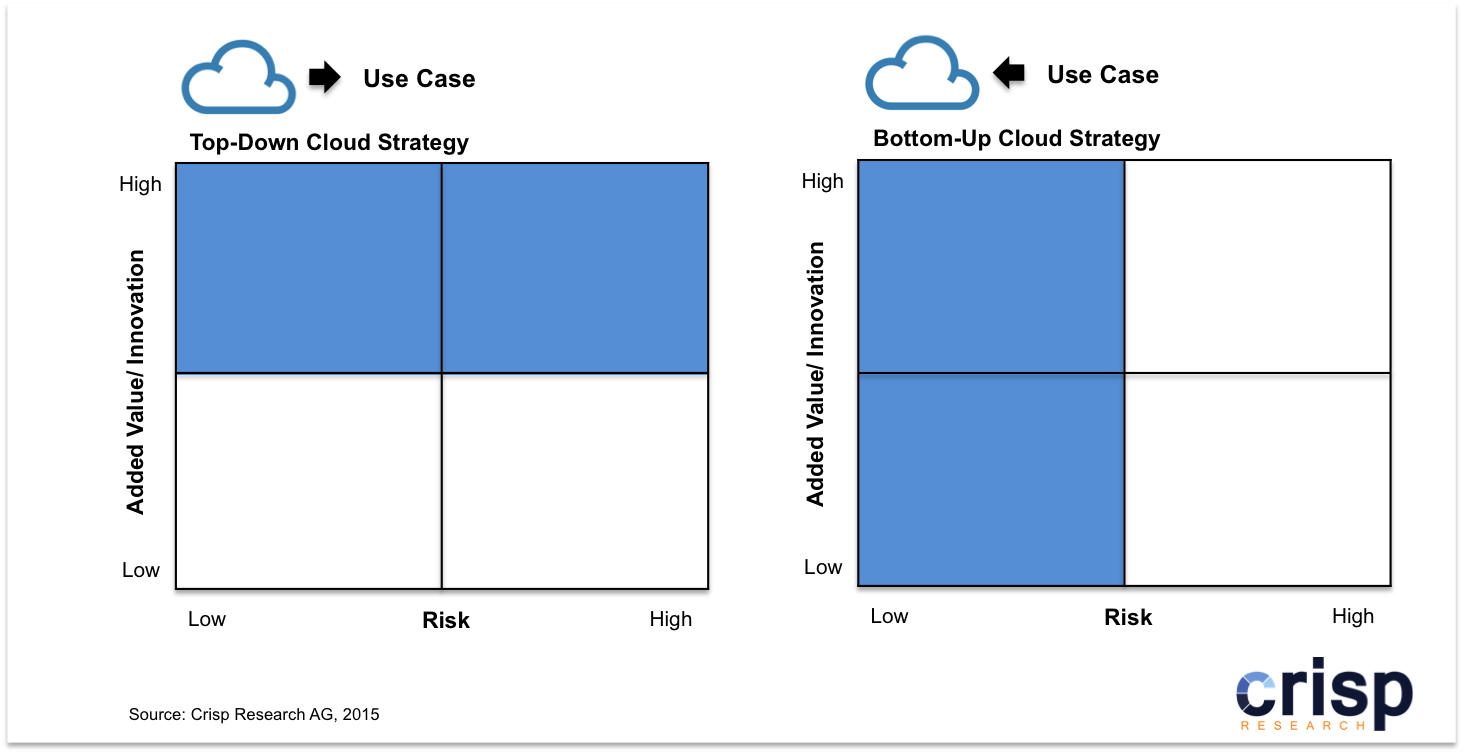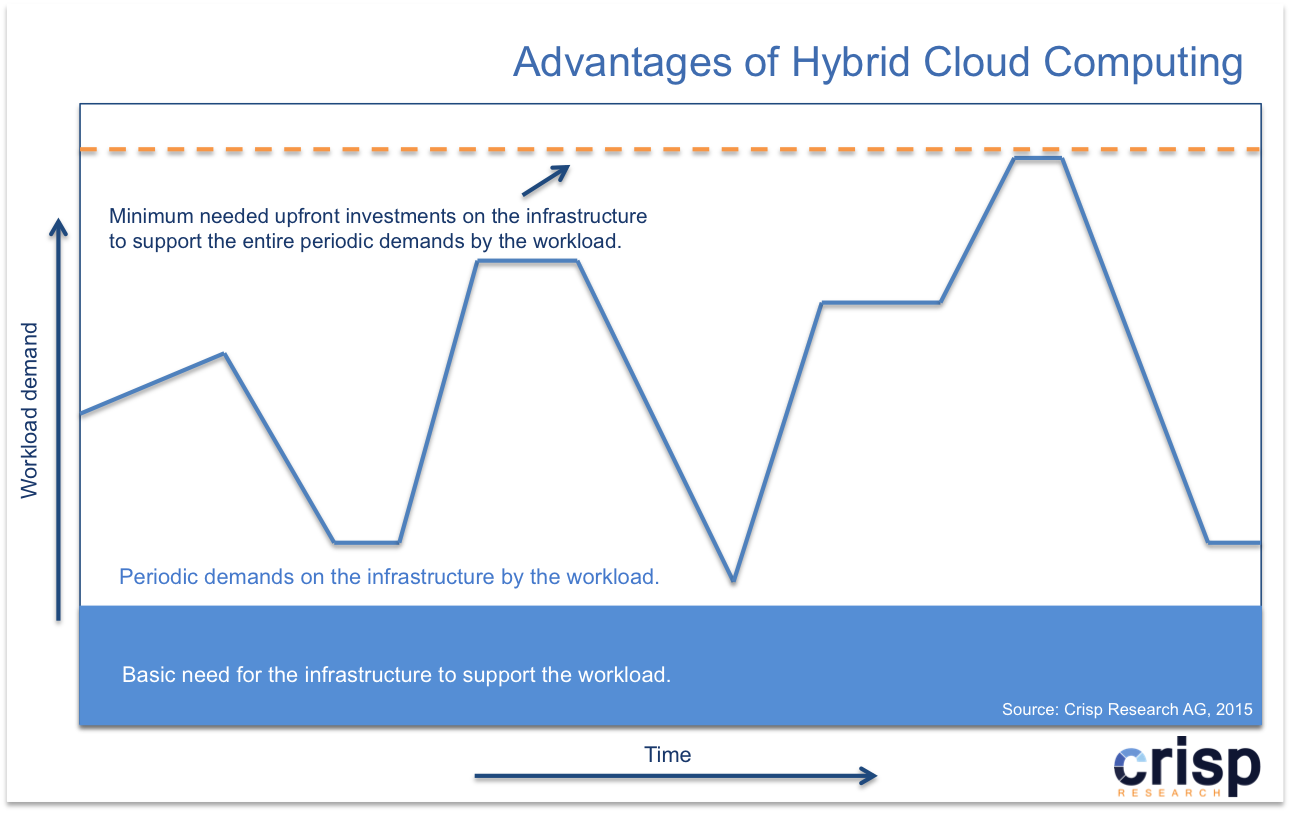The Internet of Things (IoT) has jumbled the agenda of CIOs and CTOs faster than expected and with a breathtaking velocity. As of shortly cloud, big data and social topics occupied center stage. However, in the meantime we are talking more and more about the interconnection of physical objects like human beings, sensors, household items, cars, industrial facilities etc. Who might think that the “Big 4” now disappear from the radar is wrong. Quite the contrary is the case. Cloud infrastructure and platforms belong to the central drivers behind IoT services since they are offering the perfect preconditions to serve as vital enabler and backend services.
Public Cloud Workloads: 2015 vs. 2020
The demand for public cloud services shows an increasing momentum. On the one hand it is due to the requirement of CIOs to run their applications more agile and flexible. On the other hand most of the public cloud providers are addressing the needs of their potential customers. Among the varying workload categories that are running on public IaaS platforms standard web applications (42 percent) still represent the major part. By far mobile applications (22 percent), media streaming (17 percent) and analytics services (12 percent) follow. Enterprise applications (4 percent) and IoT services are still playing a minor part.
The reason for the current segmentation: websites, backend services as well as content streaming (music, videos, etc.) are perfect for the public cloud. On the other hand enterprises are still sticking in the middle of their digital transformation and evaluate providers as well as technologies for the successful change. IoT projects are still in the beginning or among the idea generation. Thus in 2015, IoT workloads are only a small proportion on public cloud environments.

Until 2020 this ratio will significantly change. Along with the increasing cloud knowledge within the enterprises IT and the ever-expanding market maturity of public cloud environments for enterprise applications the proportion of this category will increase worldwide from 4 percent to 12 percent. Accordingly, the proportion of web and mobile applications as well as content streaming will decrease. Instead worldwide IoT workloads will almost represent a quarter (23 percent) on public IaaS platforms like AWS, Azure and Co.
Public Cloud Provider: The perfect IoT-Backend
The Internet of Things will quickly become a key factor for the future competitiveness of enterprises. Thus, CIOs have to deal with the necessary technologies to support their enterprise business technology strategy. Public cloud environments – infrastructure (IaaS) as well as platforms (PaaS) offer perfect preconditions to serve as supporting backend environments for IoT services and devices. The leading public cloud providers already have prepared their environments with the key features to develop into an IoT backend. The central elements of a holistic IoT backend are characterized as follows (excerpt):
- Global scalability
- Connectivity/ Connectivity management
- Service portfolio and APIs
- Special services for specific industries
- Platform scalability
- Openness
- Data analytics
- Security & Identity management
- Policy control
- Device management
- Asset and Event management
- Central hub
Public cloud based infrastructure-as-a-service (IaaS) will mainly be used to provide compute and storage capacities for IoT deployments. IaaS provides enterprises and developers inexpensive and almost infinite resources to run IoT workloads and store the generated data. Platform-as-a-service (PaaS) offerings will benefit from the IoT market as they provide enterprises faster access to software development tools, frameworks and APIs. PaaS platforms could be used to develop control systems to manage IoT applications, IoT backend services and IoT frontends as well as to integrate with third party solutions to build a complete “IoT value chain”. Even the software-a-as-service (SaaS) market will benefit from the IoT market growth. User-friendly SaaS solutions will facilitate users, executives, managers as well as end customers and partners to analyze and share the data generated by interconnected devices, sensors etc.
Use Cases in the Internet of Things
digitalSTROM + Microsoft Azure
digitalSTROM is one of the pioneers in the IoT market. As a provider of smart home technologies the vendor from Switzerland has developed an intelligent solution for connecting homes to communicate with several devices over the power supply line via smartphone apps. Lego kind bricks form the foundation. Each connected device can be addressed over a single brick, which holds the intelligence of the device. digitalSTROM early evaluated the potentials of a public cloud environment for its IoT offering. Microsoft Azure provides the technological foundation.
General Electric (GE) + Amazon Web Services
General Electric (GE) has created an own IoT factory (platform) within the AWS GovCloud (US) region to interconnect humans, simulator, products, sensors etc. with each other. The goal is to improve collaboration, prototyping and product development. GE’s decision for the AWS GovCloud was to fulfill legal and compliance regulations. One customer who already profits from the IoT factory is E.ON. When the demand for energy increases in the past GE typically tried to sell E.ON more turbines. In the course of the digital transformation GE early started to change its business model. GE is using operational data of turbines to optimize the energy efficiency by performing comprehensive analyzes and simulation. E.ON gets real-time access to the interconnected turbines to control the energy management on demand.
ThyssenKrupp + Microsoft Azure
Together with CGI ThyssenKrupp has developed a solution to interconnect thousands of sensors and systems within its elevators over the Microsoft Azure cloud. For this purpose they are using Azure IoT services. The solution provides ThyssenKrupp several information from the elevators to monitor the engine temperature, the lift hole calibration, the cabin velocity, the door functionality and more. ThyssenKrupp records the data, transfers it to the cloud and combines it in a single dashboard based on two data types. Alarm signals that indicate urgent problems and events that are only stored for administrative reasons. Engineers get real-time access to the elevators data to immediately make their diagnostics.
IoT-Backend: Service Portfolio and Development Capacities are central
All use cases above show three key developments that determine the next five years and will significantly influence the IaaS market:
- IoT applications are a central driver behind IaaS adoption.
- Development tools, APIs, and value added services are central decision criteria for a public cloud environment.
- Developer and programming skills are crucial.
Thus, several public cloud providers should question themselves whether they have the potential respectively the preconditions to develop their offering further to become an IoT backend. Only the ones who provide services and have development capacities (tools, SDKs, frameworks) in the portfolio will be able to play a central role in the profitable IoT market and being considered as the infrastructure base for novel enterprise and mobile workloads. Note: more and more public cloud infrastructure is used as an enabler and backend infrastructure for IoT offerings.
Various enablement services are available in the public cloud market that can be used to develop an IoT backend infrastructure.
Amazon AWS services for the Internet of Things:
- AWS Mobile Services
- Amazon Cognito
- Simple Notification Service
- Mobile Analytics
- Mobile Push
- Mobile SDKs
- Amazon Kinesis
Microsoft Azure IoT-Services:
- Azure Event Hubs
- Azure DocumentDB
- Azure Stream Analytics
- Azure Notification Hubs
- Azure Machine Learning
- Azure HDInsight
- Microsoft Power BI
Amazon AWS didn’t start any noteworthy marketing for the Internet of Things so far. Only a sub website explains the idea of IoT and what kind of existing AWS cloud services should be considered. Even with Amazon Kinesis – predestinated for IoT applications – AWS is taking it easy. However, taking a look under the hood of IoT solutions one realize that many cloud based IoT solutions are delivered via the Amazon cloud.
Microsoft considers the Internet of Things as a strategic growth market and has created Microsoft Azure IoT Services, a specific area within the Azure portfolio. However, so far this is only a best off of existing Azure cloud services that are encapsulating a specific functionality for the Internet of Things.
Public Cloud Providers continuously need to expand their Portfolio
From a strategy perspective IoT use cases are following the top-down cloud strategy approach. In this case the potentials of the cloud are considered and based on that a new use case is created. This will significantly change the ratio from bottom-up to more top-down use cases in the next years. (Today’s ratio is about 10 percent (top-down) to 90 percent (bottom-up)) More and more enterprises will start to identify and evaluate IoT use cases to enhance their products with sensors and machine-2-machine communication. The market behaviors we see for fitness wearable’s (wristbands and devices people are using to quantify themselves) today will exponentially escalate to other industries.
So, the majorities of the cloud providers are under pressure and can’t rest on their existing portfolio. Instead they need to increase their attractiveness by serving their existing customer base as well as potential new customers with IoT enablement services in terms of microservices and cloud modules. Because the growth of the cloud and the progress of the Internet of Things are closely bound together.













